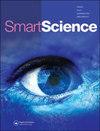花椒精油化学结构对sars - cov -2突变体D614G、N501Y和S477N刺突蛋白抑制能力的计算筛选
IF 1.4
Q2 MULTIDISCIPLINARY SCIENCES
引用次数: 2
摘要
胡椒精油中的芳香族苯基丙烯类化合物很有前景,其主导结构可以开发出针对SARS-CoV-2变体D614G、N501Y和S477N刺突蛋白的抑制剂。化学成分的结构式参考我们之前的文献报道。利用密度泛函理论(DFT)确定了它们的量子特性。利用分子对接(MD)模拟研究了配体-蛋白复合物的静态抑制性、氢键相互作用和形状互补性。所有芳香族苯丙烯,桉树醇(TH1),棕榈酚乙酸酯(TH3),丁香酚(TH4),反式异丁香酚(TH5)和丁香酚乙酸酯(TH11),预测与它们的目标蛋白形成稳定的相互作用,并对位姿几何形状表现出高度的互补性。对于各变异,最稳定的抑制体系是TH3-D614G (DS - 11.9 kcal.mol - 1;3个氢键),TH5-N501Y (DS−12.0 kcal.mol−1;TH11-S477N (DS−12.5 kcal.mol−1;4个氢键)。利平斯基的五定律证明了所研究的所有化合物的物理化学和药物相容性。该结果提出了酶抑制框架的化学型,但仍需要进一步的理论和实验工作验证。图形抽象本文章由计算机程序翻译,如有差异,请以英文原文为准。
A Computational Screening on Inhibitability of Piper Betle Essential Oil Chemical Structures against Spike Proteins of Mutated SARS-CoV-2-variants D614G, N501Y, and S477N
ABSTRACT Aromatic phenylpropenoids in Piper betle essential oil composition can be promising, leading structures to develop inhibitors toward spike proteins of SARS-CoV-2 variants D614G, N501Y, and S477N. Structural formulae of chemical constituents were referenced from our previous report in the literature. Their quantum properties were determined using density functional theory (DFT). Static inhibitability, hydrogen-bonding interactions, and shape complementarity of the ligand-protein complexes were investigated using molecular docking (MD) simulation. All aromatic phenylpropenoids, eucalyptol (TH1), chavicol acetate (TH3), eugenol (TH4), trans-isoeugenol (TH5), and eugenol acetate (TH11), are predicted to form stable interactions with their targeted proteins and perform high degree of complementarity toward in-pose geometrical shapes. Regarding each variant, the most stable inhibitory systems are TH3-D614G (DS −11.9 kcal.mol−1; 3 hydrogen bonds), TH5-N501Y (DS −12.0 kcal.mol−1; 3 hydrogen bonds), and TH11-S477N (DS −12.5 kcal.mol−1; 4 hydrogen bonds). Lipinski’s rule of five justifies the physiochemical and pharmaceutical compatibility of all studied compounds. The results propose a chemotype for enzyme-inhibiting frameworks while still requiring further verification from relevant theoretical and experimental work. Graphical Abstract
求助全文
通过发布文献求助,成功后即可免费获取论文全文。
去求助
来源期刊

Smart Science
Engineering-Engineering (all)
CiteScore
4.70
自引率
4.30%
发文量
21
期刊介绍:
Smart Science (ISSN 2308-0477) is an international, peer-reviewed journal that publishes significant original scientific researches, and reviews and analyses of current research and science policy. We welcome submissions of high quality papers from all fields of science and from any source. Articles of an interdisciplinary nature are particularly welcomed. Smart Science aims to be among the top multidisciplinary journals covering a broad spectrum of smart topics in the fields of materials science, chemistry, physics, engineering, medicine, and biology. Smart Science is currently focusing on the topics of Smart Manufacturing (CPS, IoT and AI) for Industry 4.0, Smart Energy and Smart Chemistry and Materials. Other specific research areas covered by the journal include, but are not limited to: 1. Smart Science in the Future 2. Smart Manufacturing: -Cyber-Physical System (CPS) -Internet of Things (IoT) and Internet of Brain (IoB) -Artificial Intelligence -Smart Computing -Smart Design/Machine -Smart Sensing -Smart Information and Networks 3. Smart Energy and Thermal/Fluidic Science 4. Smart Chemistry and Materials
 求助内容:
求助内容: 应助结果提醒方式:
应助结果提醒方式:


